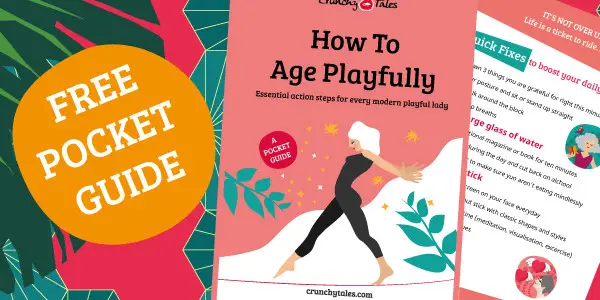Lost & Found: How I Reignited My Motivation in Midlife
‘It’s never too late to be what you might have been’. This is the quote by George Elliot that propelled me towards setting up my own business in 2018. At the age of 52, I knew that I was kidding myself – I really wasn’t enjoying my job anymore and the daily commute was becoming really tiring. Fast forward two years and I’m really enjoying running my HR Consultancy and getting involved in things I never thought possible, such as writing articles for CrunchyTales.
But I would be lying if I said it has all been easy. The truth is there have been days where I’ve just completely lost my mojo! Self-motivation takes perseverance and sometimes you just have to push forward even when you don’t feel like it. We need to find the motivation from somewhere to keep us going, especially at midlife, but the question is how do we find it when we need it most?
According to psychologist Victor Vroom, father of the Expectancy Theory, our motivation is driven both intrinsically and extrinsically. Put simply, intrinsic motivation is a drive that comes purely from within us. Extrinsic motivation, on the other hand, comes from the external rewards we get from undertaking an activity and this can be in the form of money, benefits, or recognition and praise from others around us. To be able to face up to challenges and stay motivated, we need to pull on both our intrinsic and extrinsic motivation.
Intrinsically we should start by defining our purpose and working out what it is that we really want to focus on. According to coach and motivational speaker Tony Robbins: “As the saying goes, where our focus goes, our energy flows“. To help with this we need to set ourselves goals. Research has shown, for example, that when we set specific targets for ourselves which directly matter to us, we are more likely to achieve them. So, our goals should, whenever possible, trigger intrinsic, rather than extrinsic, motivation. Intrinsic motives for a goal predict achievement and success better than extrinsic ones do.
The next ingredient to early success is to find the part of the task that you enjoy doing most and focus on that first. If you’re struggling to start, just take small steps to get into action. When I started my business, I wrote my journal every day, noting down the things that had worked well that day and the things that I found hard, or I had struggled with. The key to this activity is honesty and I found that by writing I was able to catalogue my successes and work through my obstacles.
At the start of each day, I set myself goals for that specific date, so that I didn’t get too bogged down in the long term. I just focused on the short term. For example, I knew I wanted to create a website, but first I needed to define my selling proposition. So, my goal was to work through what I had to offer to prospective clients by working out what were the unique selling points of my business. By doing this as my first task, I felt more motivated, my belief in myself grew and I was able to think further ahead.
One of the things I had struggled with in work was self -direction and so the next thing I did was to remind myself that I now had the opportunity to take more control over my work and this propelled me forward. I rewarded myself by deciding the time that I would stop work and eat, which was something that had eluded me in my workday previously. Just the fact that I could stop and prepare my own food at a time to suit me became a reward for my morning’s work.
Once I had become the master of my intrinsic motivation, I moved to extrinsic rewards, thinking through the external benefits I could gain by working for myself. I began by networking and meeting up with contacts to let them know I was ready to work. As a naturally sociable person, I realised I’d missed contact with others (something I’d taken for granted at work!) and so it became increasingly important to meet friends and ex-colleagues and find out how they were getting on. I also joined business networks to hear from others how they had started out. Listening to what other role models said about their goals helped me to find extra inspiration and raise my sights.
Interestingly, quite by chance early on in my startup, I was asked by an ex-colleague to talk at a business event. I couldn’t believe she’d asked me and cautiously I accepted, and I set about working on my presentation. The impact of this event was quite dramatic as I realised that being asked to give advice, rather than asking for it myself, was an even more effective way to overcome any motivational deficits! It boosted my confidence so much and spurred me into action. Just talking about my experiences and finding that they helped others meant that I set out the next phase of my plan, without actually realising it. This really helped my motivational mindset.
Along the way, I have had setbacks and failures and I have been fortunate that others have stepped in to motivate me just when I needed it most. Close family and friends, who know what I am trying to achieve, remind me how far I have come and what a good job I’m doing. We all need this but the secret is being honest and asking for help when you’re faltering.
What can leaders do to motivate staff?
When we think more deeply about extrinsic motivation, we realise how crucial it is for leaders to focus on what motivates their staff. The most important thing that a leader can do is find out what personally motivates the people who work in their teams and then set about helping them to achieve their goals by enabling them and empowering them.
By listening to their staff and involving them in setting their own goals, providing timely feedback and building trust, leaders can become the motivational influence on others and keep them engaged in work. A recent Gallup poll found that employees whose managers involved them in goal setting were 3.6x more likely to be engaged in their work than other employees.
In the end, we realise that motivation is not passive – it’s not something that can be done to us and instead it relies on us getting into action. We need to remember that being brave and taking the first step is sometimes the hardest thing we will ever do. Just by writing this article, I am reminded of how far I have come, and I hope my story has helped you to think about your own motivation.
I take my inspiration from author Brene Brown’s quote: “owning our story and loving ourselves through that process is the bravest thing we’ll ever do!”
Like this article? Sign up to our newsletter to get more articles like this delivered straight to your inbox.







